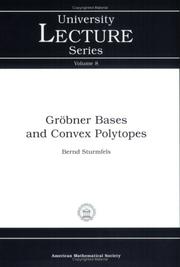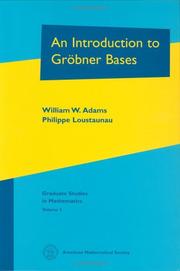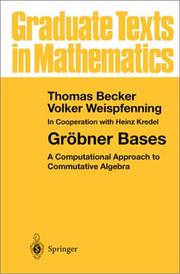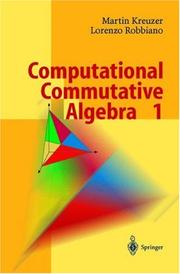| Listing 1 - 4 of 4 |
Sort by
|

ISBN: 0821804871 9780821804872 Year: 1996 Volume: 8 Publisher: Providence (R.I.) American Mathematical Society
Abstract | Keywords | Export | Availability | Bookmark
 Loading...
Loading...Choose an application
- Reference Manager
- EndNote
- RefWorks (Direct export to RefWorks)
Ordered algebraic structures --- Gröbner bases --- Convex polytopes --- 512.62 --- Grobner bases --- Polytopes --- Gröbner basis theory --- Commutative algebra --- Fields. Polynomials --- Convex polytopes. --- Gröbner bases. --- 512.62 Fields. Polynomials --- Gröbner bases

ISBN: 0821838040 9780821838044 Year: 1994 Volume: 3 Publisher: Providence (R.I.): American Mathematical Society
Abstract | Keywords | Export | Availability | Bookmark
 Loading...
Loading...Choose an application
- Reference Manager
- EndNote
- RefWorks (Direct export to RefWorks)

ISBN: 0387979719 3540979719 9780387979717 Year: 1993 Volume: 141 Publisher: New York, NY : Springer,
Abstract | Keywords | Export | Availability | Bookmark
 Loading...
Loading...Choose an application
- Reference Manager
- EndNote
- RefWorks (Direct export to RefWorks)
Gröbner bases --- ALGEBRA --- data processing --- Grobner bases. --- Grobner bases --- Gröbner basis theory --- Bases de Gröbner --- Gröbner bases --- Bases de Gröbner --- Algebra --- 512.55 --- 512.55 Rings and modules --- Rings and modules --- Commutative algebra --- Data processing --- Ordered algebraic structures --- Data processing. --- Algèbre --- Informatique --- Geometry, Algebraic --- Géométrie algébrique. --- Algorithms --- Algorithmes. --- Algèbres commutatives --- Algebra - Data processing. --- ALGEBRA - data processing --- Algèbres commutatives --- Géométrie algébrique.

ISBN: 354067733X 3540255273 3540706283 3642064914 3540282963 9783540677338 9783540255277 Year: 2005 Publisher: Berlin, Heidelberg : Springer Berlin Heidelberg : Imprint: Springer,
Abstract | Keywords | Export | Availability | Bookmark
 Loading...
Loading...Choose an application
- Reference Manager
- EndNote
- RefWorks (Direct export to RefWorks)
Computational Commutative Algebra 2 is the natural continuation of Computational Commutative Algebra 1 with some twists, starting with the differently coloured cover graphics. The first volume had 3 chapters, 20 sections, 44 tutorials, and some amusing quotes. Since bigger is better, this book contains 3 chapters filling almost twice as many pages, 23 sections (some as big as a whole chapter), and 55 tutorials (some as big as a whole section). The number of jokes and quotes has increased exponentially due to the little-known fact that a good mathematical joke is better than a dozen mediocre papers. The main part of this book is a breathtaking passeggiata through the computational domains of graded rings and modules and their Hilbert functions. Besides Gröbner bases, we encounter Hilbert bases, border bases, SAGBI bases, and even SuperG bases. The tutorials traverse areas ranging from algebraic geometry and combinatorics to photogrammetry, magic squares, coding theory, statistics, and automatic theorem proving. Whereas in the first volume gardening and chess playing were not treated, in this volume they are. This is a book for learning, teaching, reading, and most of all, enjoying the topic at hand. The theories it describes can be applied to anything from children's toys to oil production. If you buy it, probably one spot on your desk will be lost forever!
Gröbner bases --- Commutative algebra --- Grobner, Bases de --- Algebre commutative --- Data processing --- Informatique --- Commutative algebra -- Data processing. --- Gröbner bases. --- Gröbner basis theory --- Mathematics. --- Computer science --- Algebra. --- Algebraic geometry. --- Computer mathematics. --- Algorithms. --- Computational Mathematics and Numerical Analysis. --- Symbolic and Algebraic Manipulation. --- Algebraic Geometry. --- Data processing. --- Algebra --- Geometry, algebraic. --- Algebraic geometry --- Geometry --- Computer mathematics --- Discrete mathematics --- Electronic data processing --- Algorism --- Arithmetic --- Mathematics --- Mathematical analysis --- Foundations --- Combinatorial analysis. --- QA 150-272 Algebra. --- Computer science—Mathematics. --- Group theory. --- Group Theory and Generalizations. --- Groups, Theory of --- Substitutions (Mathematics) --- Commutative algebra - Data processing --- Algebre commutative - Informatique
| Listing 1 - 4 of 4 |
Sort by
|

 Search
Search Feedback
Feedback About UniCat
About UniCat  Help
Help News
News